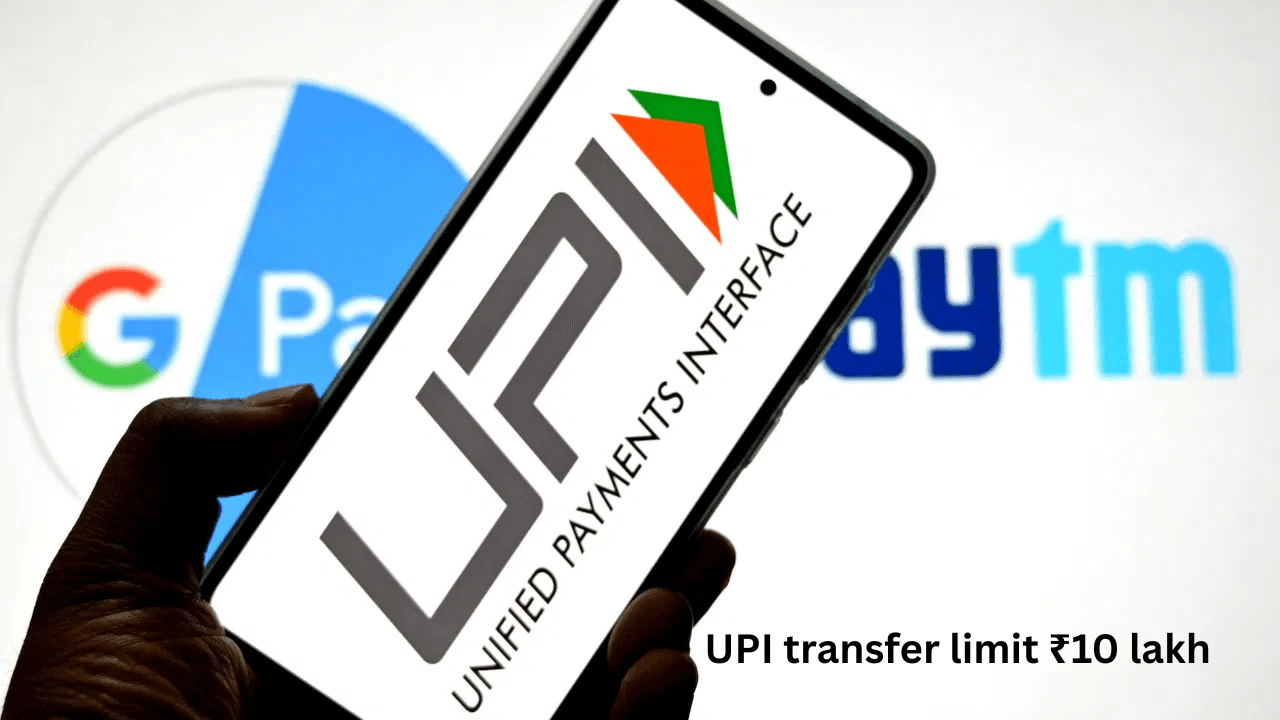UPI Limit Increased: Google Pay, PhonePe, Paytm Users Can Transfer Up to ₹10 Lakh
RBI has hiked the "UPI transfer limit" to ₹10 lakh, bringing relief to Google Pay, PhonePe, and Paytm users. Know how this change impacts your daily transactions and businesses.
UPI Limit Hiked: Google Pay, PhonePe, Paytm Users Can Now Transfer Up to ₹10 Lakh
The Reserve Bank of India (RBI) has announced a major change for digital payments in India by increasing the Unified Payments Interface (UPI) transfer limit to ₹10 lakh per transaction. This move is expected to greatly benefit both individual users and businesses who rely on UPI apps like Google Pay, PhonePe, Paytm, BHIM, and bank UPI platforms for seamless money transfers.
This decision comes at a time when UPI is already the backbone of India’s digital payment system, clocking billions of transactions every month.
UPI Limit Increased: Google Pay, PhonePe, Paytm Users Can Transfer
By raising the limit, the RBI and NPCI (National Payments Corporation of India) are reinforcing their vision of making UPI a universal and reliable mode for high-value payments.
Why Did RBI Increase the UPI Limit?
For years, the maximum daily and per-transaction UPI transfer limit had been largely capped at ₹1 lakh. Although it was later extended to ₹2 lakh for some categories like mutual fund investments and IPO applications, businesses, traders, and high-value individuals often demanded a higher ceiling.
The latest revision to ₹10 lakh aims to:
Support businesses making high-value transactions.
Provide medical, education, and travel-related payments without hassle.
Reduce the dependency on RTGS or NEFT for urgent transfers.
Accelerate India’s goal of becoming a cashless economy.
This decision reflects RBI’s commitment to empowering digital ecosystems and strengthening trust in fintech platforms.
How Does the New ₹10 Lakh UPI Limit Work?
The updated rule applies across major UPI apps such as Google Pay, PhonePe, Paytm, BHIM, and other UPI-integrated bank apps. With the higher limit, individuals and merchants can now transfer larger amounts in a single transaction.
However, the applicability may differ based on:
Banks’ discretion: Each bank can set sub-limits as per their risk and compliance rules.
KYC compliance: Only accounts with full KYC verification will enjoy the maximum benefits.
Platform updates: Users may need to update their UPI apps to use the new limits seamlessly.
In short, while RBI’s cap is ₹10 lakh, your bank may still implement safeguards like daily transaction limits or require additional authentication for higher-value transfers.
Impact on Consumers
For the average user, this change improves convenience during emergencies and large expenses.
Medical needs: Families can instantly pay hospital bills up to ₹10 lakh without requiring NEFT/RTGS clearance delays.
Education fees: Parents sending abroad tuition fees through banks supporting UPI will find it faster and worry-free.
Travel & events: High-value bookings, hotel fees, or marriage-related payments become easier through UPI instead of cheques or cards.
By removing financial bottlenecks, UPI is becoming an all-in-one payment system across value ranges.
Impact on Businesses
SMEs and large enterprises are among the biggest gainers. SMEs had often complained that the ₹1–2 lakh ceiling forced them to split payments or rely on traditional bank transfers.
Retailers and wholesale traders can now settle supplier payments instantly through UPI.
Service industries such as consultancy or event management can receive single transfers up to ₹10 lakh.
Export/import payments within India can adopt digital-first approaches without relying only on RTGS.
This change will further position UPI as a preferred choice for merchant settlements, making business operations smoother.
Security Measures for High-Value UPI Transfers
While increasing the limit offers convenience, RBI and NPCI will continue to focus on security. For bigger ticket transactions, additional authentication like OTP verification, biometric-based login, or device-binding may be applied.
Consumers are also advised to:
Double-check beneficiary details before transferring.
Avoid performing high-value transactions on public Wi-Fi.
Keep UPI app versions updated for maximum security.
These precautions ensure that ease of use does not compromise user safety.
UPI in Numbers
The growth of UPI highlights why this update matters. According to the latest figures:
Over 13 billion UPI transactions were recorded in a single month in 2025.
Transaction value crossed ₹20 trillion monthly, making UPI the dominant digital payment channel in India.
Google Pay, PhonePe, and Paytm together account for over 85% of all UPI activity, showing their massive reach across urban and rural India.
Given these statistics, the higher transfer ceiling will add even more momentum to UPI’s rising graph.
Comparing with Other Payment Modes
NEFT/RTGS: Traditionally preferred for high-value transfers, but often slower and dependent on banking hours.
Debit/Credit cards: Carry usage limits, fees, and processing charges.
UPI ₹10 lakh transfers: Now enable real-time settlement, zero charges (for individuals), and 24×7 availability.
This clear advantage could encourage even conservative users to switch from traditional fund transfer tools to UPI.
Government’s Larger Vision
The Indian government and RBI have long envisioned a digital-first economy.
From demonetization in 2016 to the launch of BHIM and the promotion of UPI Lite for small-value offline transactions, the push has been consistent.
Increasing the UPI cap is the latest milestone in achieving an inclusive yet advanced fintech ecosystem. With features like UPI autopay, credit on UPI, and international UPI-linked payments already moving ahead, the platform is evolving beyond just small transactions into a multi-dimensional financial highway.
Final Thoughts
The increase of the UPI transfer limit to ₹10 lakh is more than just a technical revision—it marks a transformative shift for India’s digital economy.
For individuals, it brings peace of mind during emergencies and big-ticket payments.
For businesses, it eases transactions, boosts efficiency, and strengthens reliance on digital platforms.
